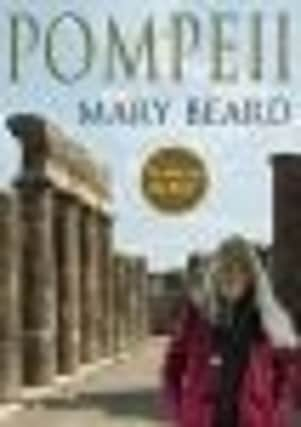Book review: Pompeii: The Life of a Roman Town by Mary Beard


And now there is a new perspective, care of eminent classicist Mary Beard, whose myth-busting, stereotype-savaging, truth-seeking excavation into one of the archaeological wonders of the world unearths some rare gems and unexpected conundrums.
Beard knows only too well the traps that lie in wait for historians and archaeologists hell-bent on reconstructing the past from dry bones and dusty artefacts, and her mission here is to make sense of what we do know, and present a more balanced picture.
Advertisement
Hide AdAdvertisement
Hide AdSo successful has been her interpretation of what she labels the ‘Pompeii paradox’ that she is to present a BBC2 documentary next month proving that ‘how the people of the town lived is actually just as interesting as how they died’.
Beard has become one of the most entertaining guides to the ancient world, taking us back through time with her easy narrative style and professorial eagle eye for classical quirks.
Here she uses her refreshing mix of scepticism and scholarship to reinterpret the evidence that has been used for centuries to make judgments not just on the events of that catastrophic volcanic eruption in 79AD but also on the people of Pompeii and their lives.
Since excavation work on the town first began in the middle of the 18th century, myths have developed and debates abounded, and what we see now as we wander through those 2,000-year-old streets is by no means the real story.
Advertisement
Hide AdAdvertisement
Hide AdScratch beneath the surface and you get a very different picture.
One of Beard’s first points of attack is the generally accepted date of the Pompeian cataclysm. The traditional dating is August 25 and 26 but many of the victims were wearing woollen clothing and the discovery of autumnal fruits and a coin which could not have been minted before late September suggest otherwise.
Also, many of the villas have been reconstructed and refurbished either because of the rough methods used by early excavators or because of extensive damage caused by Allied bombing in 1943.
The dead bodies of Pompeii – about 1,100 have been discovered over the years – provide some of the most powerful tourist images of the town.
Advertisement
Hide AdAdvertisement
Hide AdThere are women about to give birth, slaves wearing their ankle chains, lovers clinging desperately to each other and families felled by the pyroclastic flows from Vesuvius.
And yet Beard estimates that probably only about 2,000 died in the disaster, a very small proportion of a population which could have been as high as 30,000.
Most had fled long before the final devastating eruptions buried the town; they loaded up their goods and furniture onto carts and left at the first signs of volcanic activity. Those who stayed were either infirm, chained up or convinced that their homes would protect them.
There is evidence that some returned and tunnelled their way into the wreckage either to steal valuables or to recover their own goods. One particularly grand villa still has a message scrawled into its wall by a looter informing his fellow gang members that ‘this one’s been done’.
Advertisement
Hide AdAdvertisement
Hide AdIndeed, the looting goes on - in 2003 two newly excavated frescoes were prised off the wall and found three days later in a nearby builders’ yard.
But Beard’s exceptional book is about so much more than debunking. There are also plenty of those intimate and everyday stories that bring Pompeii to life... zebra-stripe colour schemes, evidence of tooth decay and rampant bad breath, amphitheatres without a single toilet, baths ‘seething’ with bacteria and foul-tasting fish sauces.
Best of all, perhaps, is the jar of wine with its delivery note still attached, addressed to ‘Mr Hospitality, the innkeeper, at Pompeii, near the amphitheatre’.
‘A visit to Pompeii almost never disappoints,’ concludes Beard, a sentiment one could apply to all her intelligent and very readable books.
(Profile, paperback, £9.99)